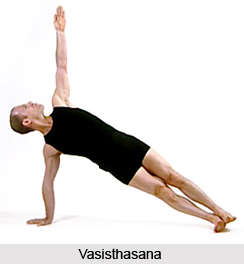 Vasisthasana is an important cultural asana named after the Vasistha, a major sage associated with the Yogic tradition. Vasisthasana is also known as the Side Plank Pose and strengthens the arms and the wrist.
Vasisthasana is an important cultural asana named after the Vasistha, a major sage associated with the Yogic tradition. Vasisthasana is also known as the Side Plank Pose and strengthens the arms and the wrist.
Meaning of Vasisthasana
Vasishtha literally means "most excellent, best, richest." Vashishta is the name of several well-known sages in the Hindu mythological tradition. Vasisthasana is a powerful arm and wrist strengthener and might also be called the One-Arm Balance. The practitioner is balanced on the same-side hand and outer foot, with your torso and legs aligned at a 45-degree angle with the floor.
Practice of Vasisthasana
A sequential process for performing Vasisthasana follows:
* Perform Adho Mukha Svanasana.
* Shift onto the outside edge of your left foot, and stack your right foot on top of the left.
* Swing your right hand onto your right hip; turn your torso to the right as you do. Support the weight of your body on the outer left foot and left hand.
* Make sure that the supporting hand isn`t directly below its shoulder; position the hand slightly in front of its shoulder, so the supporting arm is angled a bit relative to the floor.
* Straighten the arm by firming the triceps muscle, and press the base of the index finger firmly against the floor.
* Firm the scapulas and sacrum against the back torso. Strengthen the thighs, and press through the heels toward the floor.
* Align your entire body into one long diagonal line from the heels to the crown.
* One can stretch the top arm toward the ceiling, parallel to the line of the shoulders. Keep the head in a neutral position, or turn it to gaze up at the top hand.
* Stay in this position for 15 to 30 seconds.
* Come back to Adho Mukha Svanasana, take a few breaths, and repeat to the right side for the same length of time.
Then return to Adho Mukha Svanasana for a few more breaths, and finally release into Balasana.
Anatomical Focus specific for this asana is wrists, arms, shoulders, belly, buttocks and thighs.
In order to increase the strength and stability of this pose, it`s helpful to work it with your soles pressing against a wall. Perform Adho Mukha Svanasana with your heels up on a wall, the balls of your feet on the floor. When you shift onto the outside of your left foot, press the sole against the wall. Similarly, when you stack your right foot on top of the left, press that sole to the wall. Then in the pose, push your heels actively into the wall.
Effects of Vasisthasana
Vasisthasana has several beneficial effects on the human body. A selection of them is listed below.
* The asana strengthens the arms, belly, and legs.
* It stretches and strengthens the wrists.
* It stretches the backs of the legs (in the full version described below).
* Improves sense of balance.
Precautions in the practice of Vasisthasana
Aspirants with serious wrist, elbow, or shoulder injuries should avoid this pose.



